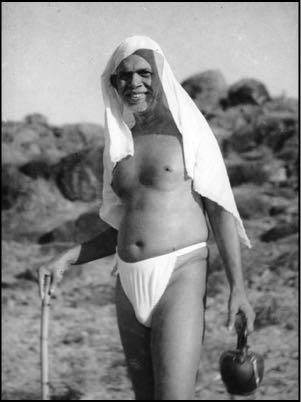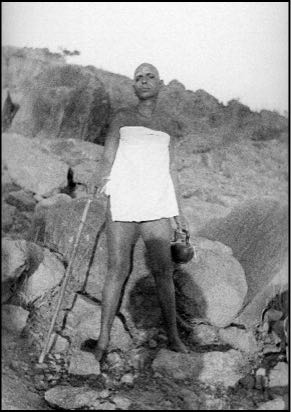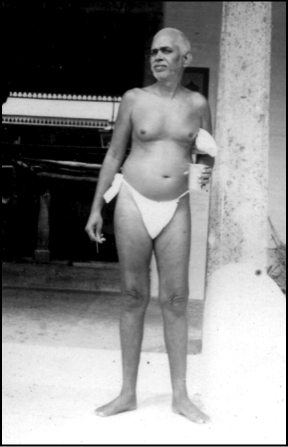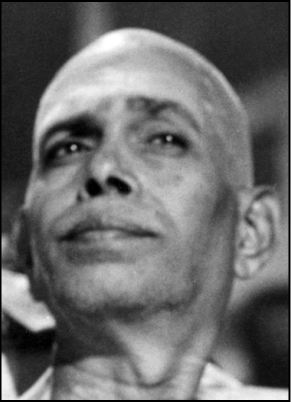



Spiritual-Teaching.org
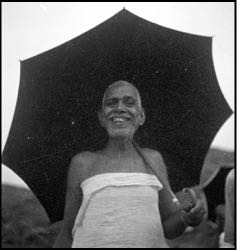
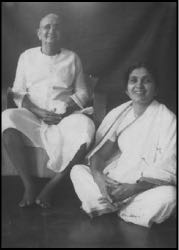
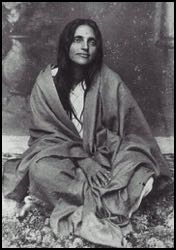
Letter # 3 - The End of a Road
“That second evening on entering the Old Hall (where Sri Ramana is present
to this day!) I was immediately astonished by the overwhelming atmosphere
of subtle that pervaded the room. It was as heavy as lead soup. There was
no need to even meditate but just to sit and soon the pervasive power would
engulf one with its healing brush.”
During the three-day stay at the ashram, I explored the institution. The ashram
was quite empty, desolate in fact, at least that is what it seemed to me as I struggled
with this new reality so different from the green vibrancy of Java. There was no one
to talk with except for one American lady who, unusually for me, I approached and
we had a short conversation about Arunachala.
What was unusual during the brief stay in the ashram was the number of hours
in which I slept. I woke up around 7.30 or 8 am, stumbled around to take a bath in
the men’s bathhouse adjacent to the gosala (cow shed), wandered about in a daze,
had lunch at 11.30 am and then promptly went to sleep again until say 3 pm. This
somnambulistic state was unfamiliar.
On the second evening around 6 pm, I entered the Old Hall for the first time. It
was largely empty aside from a few people. Among those sitting was an older
Western lady who I later discovered was Lucia Osborne.
But before proceeding further, we required a short reversion back to Java to give a
a history of my previous meditation activity. In the course of my time in Solo, Java I
studied meditation with a Javanese Hindu teacher, Pak Hardjanta. He was a
remarkable person. Scholarly, funny, sharp, kind and naturally inquisitive. A stream
of people came through his ‘office’ where he sat all day. He spent the nights awake
and would sleep from dawn to midday. He introduced me to Javanese meditation
practices of sun meditation and later, moon meditation, based on Hindu tantric
practices. One must remember that Java was Hindu until the 16th Century when it
was transformed into the Muslim country it is today.
The sun meditation practice nearly killed me. The practitioner was instructed to
lie down in an open area for ten days for an hour or so at a time, with a dark cloth
over one’s eyes and absorb the sun’s prana through the navel. In my impetuosity, far
too much was absorbed in the three days lying there and I promptly fell seriously ill.
After a week of an almost catatonic state, the physical body slowly revived and
returned to normal. Pak Hardjanta then sent me to his mountain residence at
Tawangmangu forty kilometres east of Solo, to practice moon meditation. This
involved being awake in the middle of the night, sitting outside in the cold mountain
air with the stars clustered bright as diamonds, and gazing at the moon when it had
some substantial shape. The only instruction he gave me was to go through the
moon. I had no idea what he meant but for the next two months or more, I tried and
tried. Partly puzzled, partly irritated that nothing was happening, and partly
fascinated by the grandeur of the night sky and the beauty of the moon, I persisted.
And then one night I went through the moon. It is not possible to explain it, however
with that achievement there was a concomitant release of positive joyous energy.
I was in seventh heaven. The major benefit of the moon meditation was that the
uncontrollable mood swings that hitherto governed my life subsided considerably.
A few days later I returned to Pak Ha’s office at Solo and he confirmed that the
meditation was a success. After that, there was a general deflation because there
was nothing to do. I felt adrift as Pak Ha had not given me a new instruction. For the
next weeks I continued the moon meditation in a desultory fashion for want of
anything better to do until suddenly a vision of Sri Ramana Maharshi sent me to
India.
During nearly a year in Java and being engaged with Pak Hardjanta and his
close followers I picked up without any intention or effort several siddhis. It was
possible to read minds in terms of colour patterns, dimly see auras and perceive
power centres for want of a better description to explain the accumulation of psychic
energy, tejas, in one place. For example, the Temple Mount in Jerusalem is a power
centre as are the many churches, temples and mosques in the world. In Hinduism a
temple is created by one of three ways: a Svayambhū (Skt. self-born), that is, a
natural powerpoint; for example, Arunachala or Tirumalai hill at Tirupati; the second
is the interment of a great soul; and thirdly, through rituals and prayers.
That second evening on entering the Old Hall I was immediately astonished by
the overwhelming atmosphere of subtle energy that pervaded the room. It was as
heavy as lead soup. There was no need to even meditate but just to sit and soon the
pervasive power would engulf one with its healing brush.
After three days in the ashram, I was obliged to leave and find private
accommodation outside. When I did leave, I was like a naked and vulnerable
chicken. In the course of those three days, all that I had achieved in Java was
stripped from me. Those proud, colourful feathers were gone and never returned.
And no matter in the coming days how much those wings were feebly flapped there
was no lift to give a sense of accomplishment and I felt crestfallen and bewildered.
People think that Arunachala Sri Ramana will give them what they want. It is
quite the opposite, Arunachala Sri Ramana takes away from us not only our fears
but also our desires. Bhagavan Sri Ramana Maharshi’s yoga is completely safe and
does not allow any false complacency or delusion that one is a special person. The
possible dangers of kundalini yoga and any other type of yogic practice through say
pranayama that can engender say siddhis or powers are nullified. That also includes
any fabulous but ultimately irrelevant spiritual experiences unless rightly acted upon.
These visions which are signposts to guide us and reassure us we are on the right
path, are nothing more than that and should be let go of as soon as possible once
rightly acted upon. Sri Ramana’s yoga may appear dull and slow but
hazardous it is not. A follower of Bhagavan who has received initiation
leads a perfectly normal life while that subtle invisible process forever engages the
deeper reaches of our soul in an unstoppable process of transformation.
Walking out through the front gates of the ashram was the end of my
honeymoon and the start of the serious work to destroy all the previous
illusions I tensely gripped about myself and the world.
____________________________________________________________________
